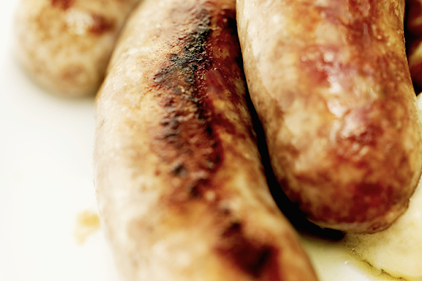Mixing time is critical in the manufacture of sausage products

When manufacturing sausage products we essentially do four things; comminute meat (comminute is a fancy word for reduction in particle size i.e. grinding, flaking, dicing or chopping), season the product, manipulate proteins and shape the product. How we perform these four activities produces the wide variety of sausage products available.

|
Mixing plays a very important role in two of these steps — seasoning the product and manipulation of proteins. When we season a sausage we want the product to have a uniform flavor profile throughout. Improper mixing can result in one part of the batch being too salty or having too intense a flavor while another part of the batch is bland. Non-meat ingredients should be evenly sprinkled over the top of the meat while the mixer is operating. Do not add the seasoning all at one time or on top of the meat when the mixer is not operating. Mixing also achieves even distribution of the fat and lean in the product.
Mixing plays a key role in how the protein is manipulated and the final texture of the product. Protein extracted during manufacture is coagulated during heating and ultimately determines the texture of the product. For example, in fresh sausage a loose texture after cooking is desirable. You want to be able to push down with a fork on a cooked fresh pork sausage patty and have it break apart. If a knife is needed to cut the patty, the texture is too tight. Consequently, you should minimize protein extraction during the manufacture of fresh sausage. Mix it just long enough to achieve good distribution of the non-meat ingredients and the fat and lean. A paddle mixer which has the tendency to be a little gentler on the meat works nicely for fresh sausage. Ribbon or auger mixers often work the meat more and increase protein extraction.
If you are manufacturing a cooked sausage such as a link smoked sausage you want to maximize the extraction of protein during manufacture. You are going to rely on extracted protein to help bind fat and moisture during cooking. The fat and moisture bound during cooking contribute to both yield and quality. Adequately bound moisture and fat is required for the product to have optimum flavor and juiciness when consumed.
During mixing we extract protein through the addition of salt, which solubilizes protein, and the imparting of mechanical energy. The longer you mix a batch of sausage, the more protein you extract. Fresh sausage is typically mixed 1 or 2 minutes, while smoked sausage is often mixed 5 to 7 minutes. The texture of meat for smoked sausage should be very sticky (extracted protein) at the end of the mixing cycle. If you put some of the meat batter into your hand and then turn your hand upside down it will stick to your hand.
If you take two identical batches of fresh sausage and mix one batch one minute and the other ten minutes, the texture of the two products will be entirely different. Consistency is a key factor in generating repeat sales and uniformity of mixing time can be a key factor in achieving consistency. Once you determine the optimum time to mix a batch of sausage, each batch should be mixed the same.
Remember: Decide on what you think is right and stick to it.
Looking for a reprint of this article?
From high-res PDFs to custom plaques, order your copy today!








